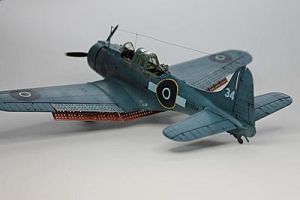SBD-5 DAUNTLESS 1:48 (Includes RNZAF decals)
Price: NZ$53.80
Code: ITA 2673
The Douglas SBD Dauntless was the standard bomber of the US navy in the first years of the Second World War. Almost 6,000 of them were constructed in six main versions, and they operated in the Pacific theatre. Of the many battles in which they took part, the Battle of the Coral Sea and the Battle of Midway come to mind. Although the technique with which this airplane was to be used, dive bombing, was soon obsolete, the SBDs remained in service. The last great operation in which they were employed on a large scale was the Battle of the Philippine Sea. They were eventually replaced by the SB2C Helldiver.
Entering service prior to Pearl Harbor, it was the Dauntless that struck back at the Japanese fleet at both the battle of the Coral Sea and Midway. Also finding service over Guadalcanal, the Dauntless continued to be used against various Japanese targets. By the end of the war the Dauntless had sunk more Japanese shipping that any other aircraft. It was the first US Navy plane to sink an enemy ship, a Japanese sub, in WWII just days after Pearl Harbor.
Model Length 246mm
No. 25 Squadron of the Royal New Zealand Air Force was formed at Seagrove, Auckland in July 1943 with Douglas SBD Dauntless dive bombers and served in the Southern Pacific based at the Piva Airstrip on Bougainville, flying missions against Japanese forces on Bougainville and at Rabaul. It was disbanded in May 1944 and reformed as a fighter/ground attack squadron flying F4U Corsairs. It served in Santo, Guadalcanal, Los Negros and Emirau, before returning to New Zealand and being disbanded in September 1945. A SBD-4 Dauntless operated by 25 Squadron was for a time preserved in the Royal New Zealand Air Force Museum at Wigram, displayed in the condition which it was recovered after being lost with its crew while on a training mission at Espiritu Santo. One of the SBD-5 aircraft operated by 25 Squadron has been restored to flying condition in America for the “Planes of Fame” museum, in the colour scheme of an American aircraft.











